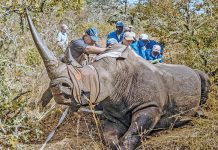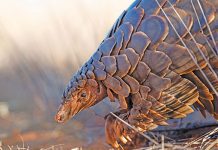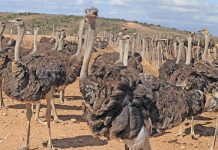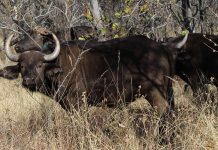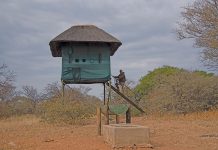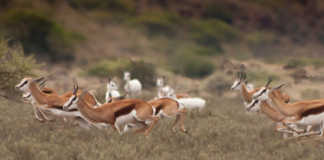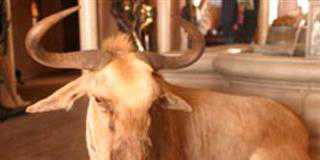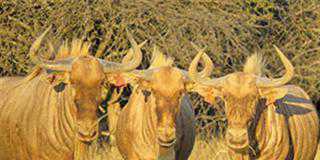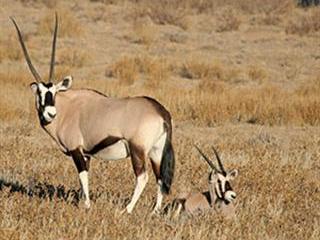
“We tracked game with highly skilled San trackers, we hunted on foot and camped under a canopy of stars on this exceptionally beautiful game ranch in the Kalahari near Askham. Rolling grasslands and camel thorn trees surrounded us. If you enjoy pure hunting, it doesn’t get better than this.” High praise from Louis Marais, an experienced hunter from Pretoria, who took part in one of four annual hunts, guided by the Khomani San, on Erin, their 6 000ha game ranch, last year.
Louis and his hunting party of five so enjoyed themselves that they made a repeat booking for this year. “The condition of the animals was excellent. There are four Kalahari game species (gemsbok, blue wildebeest, red hartebeest and springbok) on offer and the guides were wonderful to hunt with,” says Louis. The hunters said the San intuitively understood when guests needed time alone. As a bonus they found the venison tasted unusually good. It has taken several years to get Erin to what it is today – a well-stocked, community-run, commercial game and hunting ranch.
About 200 game animals were donated to Erin by SANParks and Tswalu Kalahari Game Reserve. The remainder were bought by the Khomani San, descendents of South Africa’s first people who hunted, gathered and later herded their livestock in the Kalahari and other parts of South Africa. In the apartheid years, the San were dispossessed of their ancestral land in the Kalahari, a large part of which is now the Kgalagadi Transfrontier Park.

Five members of the Khomani San clan undertook field guide training in 2011 and were appointed to work as veldwagters and cybertrackers. From left: Jeffrey Kruiper, Dawid Kruiper, Fazel Farrell, Isak Kruiper and Elvis Swartz. Photo courtesy of Phillipa Holden
In 1995, under the leadership of the legendary head of the clan, Dawid Kruiper, who died last year, 160 Khomani San clan members applied to have their land returned to them. Six farms, including Erin, making up a land area of 36 000ha outside the Kalahari Gemsbok National Park were returned to the Khomani San in 1999. A further 25 000ha inside the park was granted. Because of lack conflict and a lack of capacity and the promised follow-up support, it was 12 years before the San could freely access the park and begin to develop their land.
Support
Ecologists Dr David Grossman and Phillipa Holden van Zyl have provided support and back-up on a monthly basis. “We’re in year 15 of a 6-month project,” says David with a smile. To help the Khomani San develop their land, David and Phillipa sourced funding and contributed their considerable skills to the project. Funders include the WWF Nedbank Green Trust, the National Lottery Fund, Wildlife Ranching South Africa (WRSA), SANParks and Tswalu Kalahari Game Reserve.
With the assistance of Ghoenaskraal Training Centre and WRSA, a number of San field rangers, hunting guides and game farm assistants have been trained and certified, including Blade Witbooi and Katrina Koper, who manage Erin. Blade is also Erin’s huntmaster, a job in which he is assisted by a team of trackers, including San elder Isak Kruiper, cousin of the late Dawid Kruiper. Following in Dawid’s footsteps, both men have a wide knowledge of indigenous medicinal and food plants.
“We have also run training courses for the Khomani San in game meat processing, abattoir hygiene and game skin tanning,” says Professor Piet du Plessis of Ghoenaskraal Training Centre. A retired professor of management accounting, Prof Du Plessis’s expertise helps optimise the ranch’s income. “Training is important and over the past six years we have concentrated on professionalising everything from the hunt to hospitality at Erin,” says Prof Du Plessis. He and his two sons go on the first hunt of the year at Erin to ensure that quality is up to standard.

The legendary Dawid Kruiper, Khomani San leader of many years who died in June 2012. He understood that times have changed but he wanted to ensure that the culture and knowledge of the first people was kept alive. Photo courtesy of Phillipa Holden
“The Khomani San are real veld people; they understand the bush and they grasp the concept that ethical, walk-and-stalk hunting is what the clients are looking for. “Our feedback is that the hunters enjoy the hunt at Erin, which is wonderful because these are an extraordinary people with unique status and it is important that this venture is a success.”
Skills and technology
With Erin’s first trophy hunt on the cards Blade and two staff members will complete a professional hunting course this year. Hunting rifles are used on the hunts, although some of the community can still hunt with bow and arrow. Traditional hunting is a dying art as the elders who make the bows and arrows, and who once hunted traditionally to sustain themselves, are getting older. The income from the hunts on Erin is used to manage and maintain the farm and pay staff salaries.
“We are very proud of Erin; the animals look good and are calving well. We try our best for the hunters and this year, we hope to increase to five or six hunts,” says Blade. “We provide toilets for the hunters at the camping site and we have good slaughter facilities and cool rooms. At the moment we use a generator but we would eventually like to switch to Eskom power.”
Blade once worked as a farm labourer on the land now owned by the Khomani San. “There was some game on Erin back then, as well as cattle and sheep. And there were camels. I think they were used by the police 100 years ago. We still have some bulls left but no cows,” explains Blade. He is assisted by five rangers who patrol the game farm, check the fencing and water points and collect field data on hand-held GPS equipment.
Information about plant and animal populations is entered and data is downloaded onto the cyber tracker system. This process creates an interface where inter-generational knowledge and ancient wisdom can be transferred and used through modern technology. The information is used to decide the number of hunts Erin can reasonably host. Barbara Raats, who works in the office at Erin, became computer and GIS literate with the help of Craig Beech of the Peace Parks Foundation.
Land restitution
Khomani San clan members live on Erin and other reclaimed farms, many of them in traditional Bushman dwellings. “It was a miracle that we got our land back. We would not be here without the help of many good people. We are so grateful to David and Phillipa. They must never go away from us, they are part of our family; they are Khomani San now,” says Blade.
In 1999, the Khomani San land claimants were told they would soon be back on their land. Their celebration of this momentous event was to be short-lived.

Dr Koos Marais, of Pretoria, with Isak Kruiper during the 2012 hunt. ‘We walked and walked and climbed one hundred dunes. This year we’ll be back for more,’ says Koos. To view the YouTube video of their hunt go to www.youtube.com and type in Jag saam met die Boesmans. Photo courtesy of Louis Marais
The following years saw David and Phillipa battling alongside the original claimants against more than 1 500 newcomers who had descended, from various parts of the Northern Cape, claiming some form of Khomani San ancestry. Many were simply cashing in on the claim while attempting to oust the original claimants. “During this time we secured legal representation and were poised to take Land Affairs to court,” says David.
“In 2007 they finally agreed to work with us and to start sorting out the mess, including establishing the rightful claimants, and meeting their commitments to the Khomani San. “These include preparing an overall management plan for the land and appointing a manager.” Several matters remain unresolved and the case, currently before the High Court in Kimberley, will hopefully be settled early this year.
Despite this, from 2007 the Khomani San projects, which included the development of Erin, started taking off. The Khomani San now have their own gate into the Kalahari Gemsbok National Park. The San gate provides them and their guests access to their portion of land (25 000ha) within the Kalahari Gemsbok National Park, now part of the Kgalagadi Transfrontier Park. Their land in the park was re-proclaimed as a contractual park in 2003.
There, the San issue visitor permits and run a modest camp, which charges R50 to R100 a night. A powerful drawcard for visitors is going on game trails guided by San trackers who have a vast knowledge of the wide range of desert animals, including its six different cats: lion, leopard, cheetah, caracal, African wild cat and black-footed cat.
Heritage site
The Khomani San’s ancestral land has been placed on Unesco’s tentative World Heritage Site list. A film, based on adventurer and author Patricia Glyn’s two-month heritage mapping journey through the Kgalagadi with Dawid Kruiper and members of his clan shortly before he died, is being made. Many tales about legendary characters of the Kalahari are told – such as the one about how grandfather Makai! Kruiper, enslaved by the Nama people, had escaped in a battle between the Namas and the Germans.
For the Khomani San occupying and developing the land of their ancestors is a highly significant and indeed spiritual event. We could remember the words of Laurens van der Post, “The bushman personified an aspect of natural man which we all have, but with which we’ve increasingly lost contact…”
Hunting at Erin
Hunters must be fully self-sufficient and bring their own camping equipment, food and beverages, including drinking water. Hunting parties are responsible for removing all their refuse, down to cigarette stubbs. Water for a camp shower is provided. Current prices for South African non-trophy hunters are: springbok: R575 (international hunters: R760), gemsbok: R3 000 (international: R4 000), red hartebeest: R2 750 (international: R3 500), blue wildebeest: R2 450 (international: R3 600).
Daily camping:
- R100/person/day.
- Skilled tracker guide: R260/day.
- Skinners or camp attendants: R155/day
Trophy hunting:
- Roland Ward or Safari Club International trophy prices on application.
Getting to Erin:
Hunters can fly in and land on a pan about 4km from Erin. It’s a day’s drive from Gauteng. The closest town is Askham on the road to Rietfontein and the closest big town is Upington which also has an airport.
Contact Dr David Grossman on 083 266 6244 or email [email protected]
For information on the Khomani San, visit www.khomanisan.com

